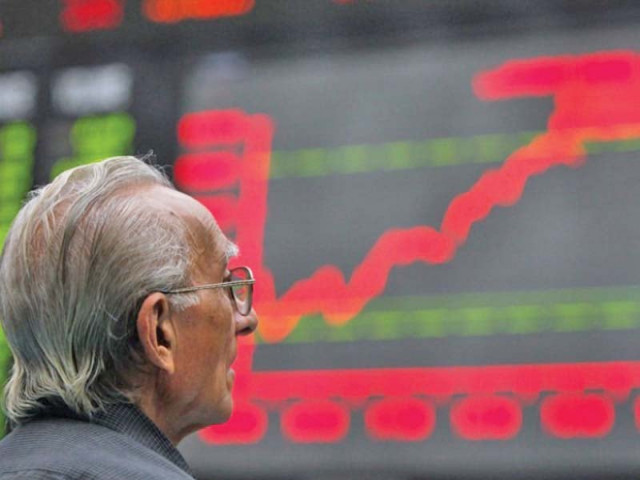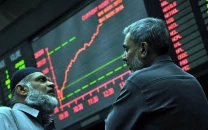Myths about the stock exchange
Return of inflation-adjusted KSE-100 Index an eye-opener

Return of inflation-adjusted KSE-100 Index an eye-opener. PHOTO: REUTERS
You might want to re-think everything you know about the stock exchange.
Stock indices are like balloons. The Karachi Stock Exchange (KSE)-100 Index is the primary indicator of the equity market in Pakistan. It represents over 85% of total market capitalisation of all companies listed on the KSE.
Thirty-two companies on the index are the most capitalised firms in their respective industrial sectors. The remaining 68 are the next highest capitalised firms in descending order of capitalisation.
Karachi Stock Exchange has a great fall
The index compares current market capitalisation to the market cap in November 1991 (the base period), which was normalised to 1,000 points. As a toy example, suppose that in November 1991, there were just two firms, A and B, on the stock index. Firm A had 500 shares of Rs10 each, while B had 100 shares at Rs50 each. Then the total market cap would be Rs10,000. We would divide this market cap by 10 to normalise to 1000 index points. Now suppose that the next day, price of A’s shares doubled to 20, while the price of B decreased to 40. The new market cap would be 500 times 20 for A plus 100 times 40 for B, or 14,000. Again, we would divide by 10 to normalise the cap to 1,400 index points.
This simplified version of the KSE 100 suggests an obvious pitfall. Suppose that during its first day, as the stock index climbed from 1,000 to 1,400, inflation rose by 100 percent. The rupee lost value, so that whatever cost Rs10 the previous day cost Rs20 the next. Inflation would affect the stock index as well. While in nominal terms the index increased by 400 points, in “real” or inflation-adjusted terms, it decreased by 300 points. In particular, A’s shares cost more only because the rupee was worth less.
New listings will help integrated stock exchange
Ignorance of inflation is prevalent, but selective. When we buy fast-moving consumer goods, such as bread, for twice the price they were at before, we are aware that they are the same goods, sans improvements.
However, a person who buys a car for Rs1 million in 2000 and sells it Rs1.1 million in 2005 may well think he has profited. With the stock index, people expect rapid price changes from day to day and will often fail to disentangle price changes that are caused by inflation from price changes caused by the firm’s performance.
In a country with low inflation, such as the US, this problem is significant but relatively small. In Pakistan, however, ignorance of inflation can be catastrophic.
Returning to our toy example, suppose that a person holding 200 shares of Firm A decides to sell them on the second day. This seems eminently reasonable to him since the share price has doubled. If he bought the shares at Rs10 apiece and now sells them at Rs20 apiece, his capital gains are Rs2,000. Given the capital gains tax rate of 17.5% -- since the holding period is six months or less – or Rs350, he has taken home just Rs1,650. In a tax-free world, he would have just broken even. With the capital gains tax, though, he is Rs350 poorer. Of course, if the increase in the share price had been lower than inflation, our trader would have been worse off, even in a tax-free world.
MoU for Pakistan Stock Exchange signed

Business experts and investment gurus routinely neglect inflationary effects on the stock index. This may seem surprising given their credentials, but it is unsurprising given their incentives. Investment professionals profit from stock market activity, and have every reason to exaggerate stock market returns and lure investors. There is no law requiring the stock index to take account of inflation, or investment advisors to adjust the index when they provide commentary or advice.
The graph compares the nominal KSE 100 to the inflation-adjusted KSE-100. To adjust for inflation, the KSE index has been divided by the proportional change in the Consumer Price Index for each year.
Note that an increasing proportion of the KSE 100’s apparent gains comes from inflation, and disappears with inflation-adjustment.
Last three years: Market capitalisation grows 111%, but listings down 5%
This is no reason to divest stock investments. For people who can hold their investments, the KSE-100 provides a hedge against inflation. In addition, people who have special knowledge about the potential of a firm or industry can still make remarkable profits, even after adjusting for inflation. However, to the unsophisticated investor and short-term trader, the inflation-adjusted index should suggest caution. High frequency traders who ignore inflation are liable to boil like the proverbial frog.
The writer is a professor of law and adjunct professor of business at Lums
Published in The Express Tribune, October 19th, 2015.
Like Business on Facebook, follow @TribuneBiz on Twitter to stay informed and join in the conversation.



















COMMENTS
Comments are moderated and generally will be posted if they are on-topic and not abusive.
For more information, please see our Comments FAQ